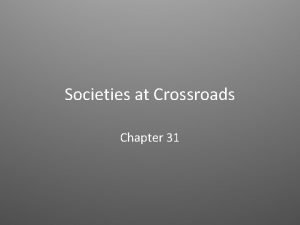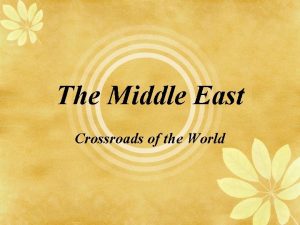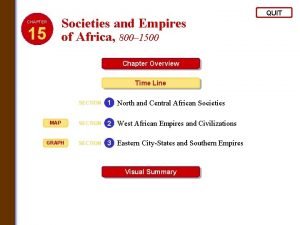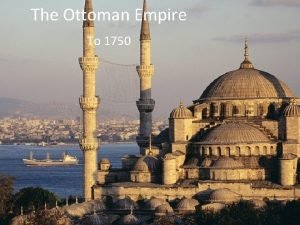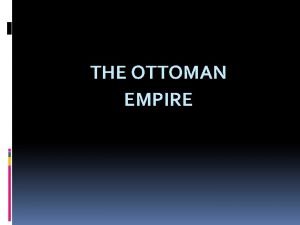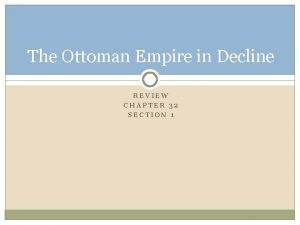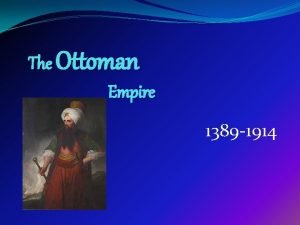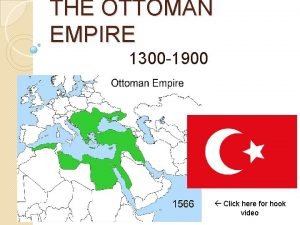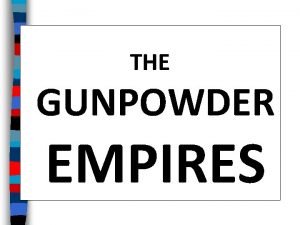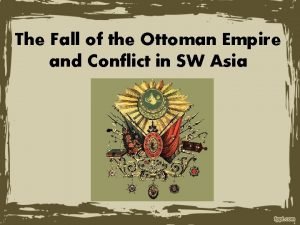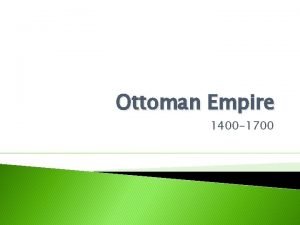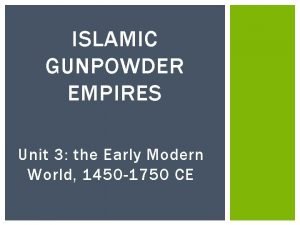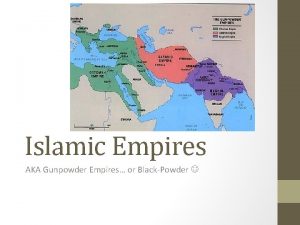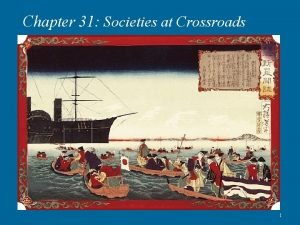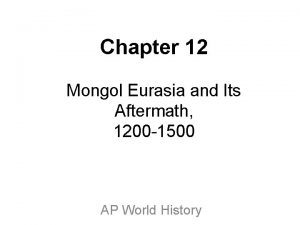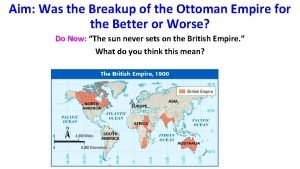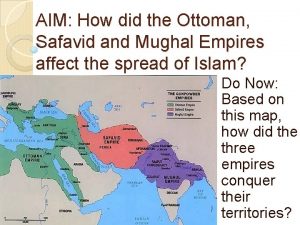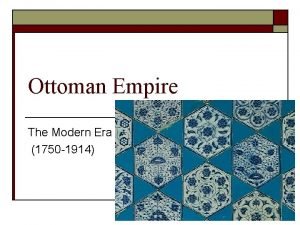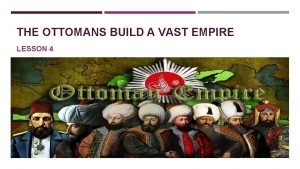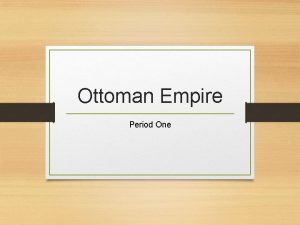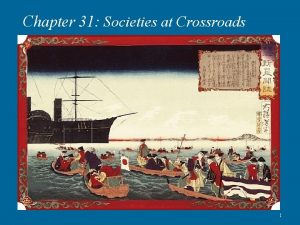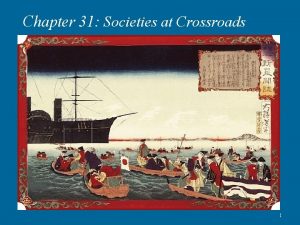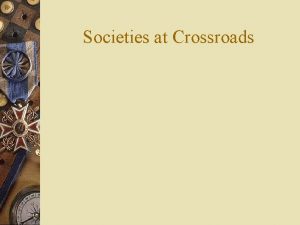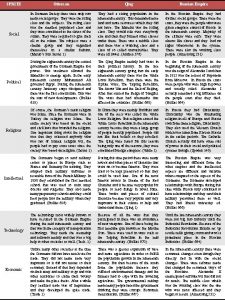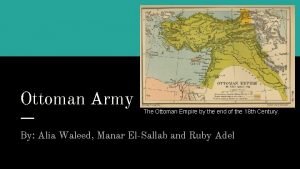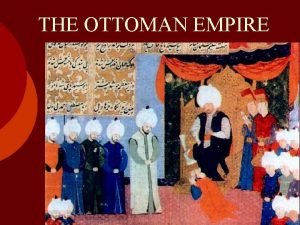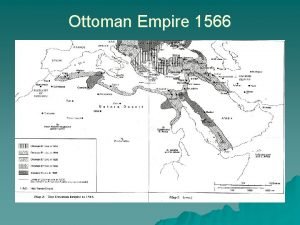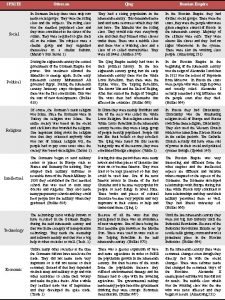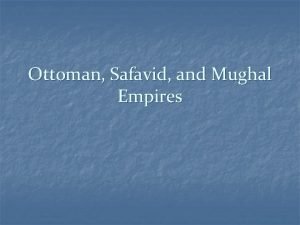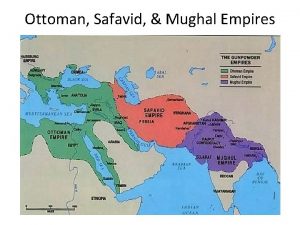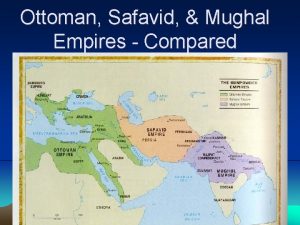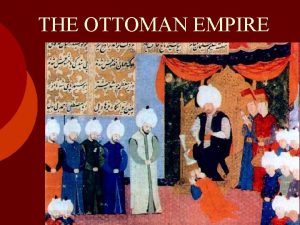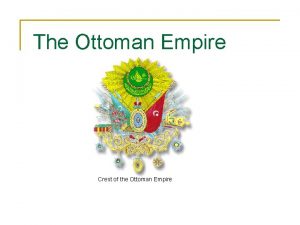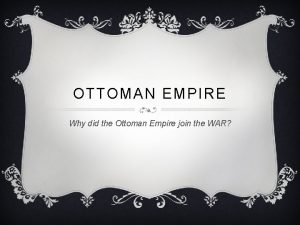Chapter 31 Societies at Crossroads 1 The Ottoman











































- Slides: 43

Chapter 31 Societies at Crossroads 1

The Ottoman Empire in Decline • Ottoman empire reached peak of military expansion in late seventeenth century • Defeated by Austrians, Russians, largely due to European advances in technology and strategy • Elite Janissaries controlled large parts of government and economy • Semi-independent local warlords used mercenaries, slave armies to support sultan in return for imperial favor • Massive corruption, misuse of tax revenues • Decline and end of Ottoman empire due to lack of modernization and large foreign debt and influence 2

Territorial Losses • Russia took territories in Caucasus, central Asia • Nationalist uprisings drove Ottomans out of Balkans • Napoleon’s unsuccessful attack on Egypt spurred local revolt against Ottomans under Muhammad Ali (r. 1805 – 1848) • Nominally subordinate to Sultan, but threatened capture of Istanbul • British supported Ottomans only to avoid possible Russian expansion • Austria Hungary gave semi autonomy to Bosnia and Herzegovina 3

4

Economic Difficulties • Imports of cheap manufactured goods put stress on local artisans; led to urban riots • Export-dependent Ottoman economy increasingly reliant on foreign loans • By 1882, Ottomans unable to pay interest on loans, forced to accept foreign administration of debts • Capitulations: agreements exempting Europeans from Ottoman law • Extraterritoriality gave tax-free status to foreign banks, businesses • Lawfully protected Christians right to worship in Ottoman territory 5

6

Muhammad Ali • After Napoleon’s attack on Egypt (1799), Mamluk Egyptians led by Ottoman Muhammad Ali, revolted against French rule. • Ali would go on to take over Mecca, Medina and Syria for the sultan. Eventually Ali would lose at the Battle of Navarino, allowing Greece to gain independence • Ali had semi autonomy from the Sultan and instituted many reforms in Egypt • Conscription • Textile Industrialization • Ali found major resistance to conscription from the Janissaries; they were used to all the perks of being the Sultan’s exclusive army • Ali’s descendants would rule Egypt until 1952 7

8

Reforms and Reorganization • Attempts to reform taxation, increase agricultural output, and reduce corruption • Sultan Selim III (r. 1789– 1807) remodeled army on European lines • Janissaries revolted, killed new troops, imprisoned sultan and killed him • Islamic scholars (ulama) did not like the opening of secular primary schools and colleges • Sultan Mahmud II (r. 1808– 1839) abolished Janissary service, had Janissaries massacred who revolted • Also reformed schools, taxation; built telegraph, postal service • Ended feudal state tax collection Legal and Educational Reform • Tanzimat (“reorganization”) era, 1839– 1876 • Pace of reform accelerated • New law codes drafted for commercial and penal law • Ottoman Reform Edict declared equality for men • Undermined power of traditional religious elite (Ulama) • Fierce opposition from religious conservatives, bureaucracy • Also opposition from radical Young Ottomans, who wanted constitutional government to support Turkification 9

10

Start of Ottoman Decline • The major resistance by groups like the Young Turks, the increasing influence of European nations and money, led to the decline of the Ottoman Empire • Germany wanted to build a railroad but needed Ottoman government to agree to extraterritorialities to allow banking centers to be built. This allowed Europeans to follow their own laws and religions while in Ottoman territory. • The economy became so dependent on foreign goods and money that exports were low and the agricultural economy was virtually nonexistent. The Ottoman economy survived as a trading hub. • This led to scapegoating. Armenian Christians were killed by the Ottoman government. 1. 5 million 11

The Young Turk Era • Angry at the role of European nations and the Tanzimat reforms, revolts began by the Turkish people. Wanted Turkification in the constitution, which was problematic as it suppressed ethnic minorities in a diverse empire. • Attempted to establish Turkish homogeneity over farflung empire • Turkish made official language, despite large numbers of Arabic and Slavic language speakers • Yet could not contain forces of decline. Ottomans resented how much influence European nations had on the government and large foreign debt owed to those nations. Ottoman empire will ally with Germany in hopes of erasing a lot of debt upon winning WWI. 12

13

The Russian Empire Under Pressure • Russia a massive, multi-cultural empire from Poland to Pacific Ocean • Only approximately half spoke Russian, observed Russian Orthodox Christianity • Romanov tsars ruled autocratic empire with the support of the wealth landowning nobles • Powerful class of nobles exempt from taxation, military duty • Peasants made up the majority of the population, most were serfs bound to the land • Emancipation of serfs was the keystone of the Romanov tsars 14

15

The Crimean War (1853– 1856) • Russian expansion into Caucasus in larger attempt to establish control over weakening Ottoman empire • Threatened to upset balance of power; led Europeans to become involved • Russia driven back from Crimea in humiliating defeat on their own land • Demonstration of Russian weakness in face of western technology, military strategy, weakened agrarian economy • This major defeat caused the Tsars to reevaluate and undertake massive reforms 16

17

18

Emancipation of the Serfs • Serfdom was source of rural instability and peasant revolt • “It is better to abolish serfdom from the above than to wait until the serfs begin to liberate themselves from below” • Serfs emancipated by Tsar Alexander II in 1861, without alleviating poverty, land hunger (Emancipation Manifesto) • Forced to former serfs to pay for lands they had farmed for generations • Government paid for land labor loss to landowners • In the end, no major impact on agricultural production. Most former serfs were economically worse off but had their freedom. • Political and Legal Reform • Network of elected district assemblies called zemstvos for issues like health, education and welfare • Zemstvos were still subordinate to the Tsars • 1864 revision of the Judiciary system • Fought corruption, allowed for trial by jury 19

Industrialization in Russia • Social and political reform coincided with industrialization. With serfdom abolished, freed people were a source of labor. • Different than Western European industrialization. It focused on political and military advantages, instead of commercialism. • Witte system • Count Sergei Witte, minister of finance 1892– 1903 submitted a plan to the Tsar about how to stimulate the economy. • Massive railroad construction (Trans-Siberian railroad) • The railroad was paid for by foreign investment • Coal, oil, steel industries would boom • But massive industrial discontent • Peasants uprooted from rural lifestyle • Revolts from laborers over low wages, long hours, poor working conditions allowed under the Witte system • The government did not response favorably to the revolts. This led to revolutionary ideas being easily accepted by the working class. 20

21

Protests and Repression • Intelligentsia spread radical ideas for change • Socialists, anarchists • Terror tactics, assassinations • Anarchist attempted to connect with mistrustful peasantry in 1870 s; denounced and sent into Siberian exile by the Tsar • Tsarist authorities turned to censorship, secret police to stop the spread of radical ideas • Growth of nationalist sentiment in Baltic provinces, Poland, Ukraine, Georgia, central Asia led to the Tsar responding with Russification • Jews were targeted, Tsarist authorities supported pogroms that attacked Jews. This led to the mass migration of Jews to Western Europe and U. S. 22

23

Terrorism and Revolution • 1881: assassination of Tsar Alexander II by radical Peoples’ Will movement • Used terror tactics to pressure prominent government officials to adopt reforms • Prompted widespread pogrom attacks on Jews • Increased repression from tsars in response to radicalism • Nicholas II (r. 1894– 1917) entered into war with Japan (1904– 1905) to distract from domestic problems (Russo-Japanese War) • The expansion into Manchuria and Korea conflicted with Japan’s expansion plans • Humiliating defeat exposed government weaknesses • Social discontent boiled over in revolution, 1905 • A group of workers marched on the tsar’s St. Petersburg palace to petition Nicholas for political reforms. The government met the workers with rifles; killing 130 (Bloody Sunday). • Once news of Bloody Sunday spread, uprisings and mutinies rose • Peasants and urban workers organized themselves into groups called Soviets • Turmoil forced government to make concessions in the form of the Duma • The creation of the Duma did not save the Romanov Tsars from the 1917 Russian Soviet Revolution 24

The Chinese Empire Under Siege • Since 1759, European commercial presence limited to port of Guangzhou • Foreign merchants forced to deal solely with licensed Chinese cohongs • Currency of trade: silver bullion • British East India Company heavily involved in opium trade • • • Opium grown in India, sold in China for silver; silver used to buy other Chinese products Illegal, but poor enforcement Increasing trade and social ills evident by late 1830 s Chinese moved to enforce ban British agents engaged in military retaliation: the Opium War (1839– 1842) Chinese easily defeated by British naval forces • Unequal treaties • • China forced into a series of disadvantageous treaties Hong Kong ceded to British in Treaty of Nanjing (1842), ports opened to British traders Extraterritorial status to British subjects Later, other countries concluded similar treaties leading to spheres of influence 25

26

The Taiping Rebellion (1850– 1864) • Large-scale rebellions in later nineteenth century reflected poverty, discontent of Chinese peasantry towards the emperor • Population rose 50% between 1800– 1900, but land under cultivation remained static • Nian rebellion (1851– 1868), Muslim rebellion (1855– 1873), Tungan rebellion (1862– 1878) • Taiping rebellion led by Hong Xiuquan, schoolteacher; called for destruction of Qing dynasty The Taiping Program • Abolition of private property • Creation of communal wealth • Prohibition of foot binding, concubines • Free public education, simplification of written Chinese, mass literacy • Prohibition of sexual relations among followers (including married couples) • Yet leaders maintained harems 27

Taiping Defeat • Nanjing captured in 1858, made into capital • Attack on Beijing with force of 1 million, but turned back • Imperial army unable to contain Taipings, so regional armies created with Manchu soldiers and outfitted with European weaponry • Hong committed suicide in 1864; Nanjing recaptured • 100, 000 Taipings massacred 28

The Self-Strengthening Movement (1860– 1895) • High point in 1860 s– 1870 s. Modernization was inevitable • Slogan: “Chinese learning at the base, Western learning for use” • Blend of Chinese cultural traditions with European industrial technology • Shipyards, railroads, academies • Changes Chinese economy and society superficial • Empress dowager Cixi (1835– 1908) diverted funds for her own aesthetic purposes 29

Copyright © 2015 Mc. Graw-Hill Education. All rights reserved. No reproduction or distribution without the prior written consent of Mc. Graw-Hill Education. 30

Spheres of Influence • Qing dynasty’s loss of influence in southeast Asia, loss of tributary states to Europeans and Japanese • Vietnam to France, 1886 • Burma to Great Britain, 1885 • Korea, Taiwan, Liaodong Peninsula to Japan, 1895 (Sino-Japanese War) • China itself divided into spheres of influence, 1895 31

32

33

The Hundred Days Reforms (1898) • After the defeat in the Sino-Japanese War, many groups started to form to protest issues • Kang Youwei (1858– 1927) and Liang Qichao (1873– 1929) • Interpreted Confucianism to allow for radical changes to system • Pro-industrialization, European medical and commercial systems • Abolished civil service exam (2, 500 years old) • Emperor Guangxu attempted to implement reforms • Empress dowager Cixi nullified reforms, imprisoned emperor • Cixi was terrified of the influence of foreigners and technology. She halted the railroad construction in China. 34

35

The Boxer Rebellion • Cixi threw support behind Society of Righteous and Harmonious Fists (“Boxers”), anti-foreign militia units • 1899, fought to rid China of “foreign devils”. Targeted Christian missionaries and converts • Misled to believe European weapons would not harm them, 140, 000 Boxers besieged European embassies in 1900 • Crushed by coalition of European forces • China forced to accept stationing of foreign troops and pay for war costs • Empress Cixi had to admit she was wrong (!!!!) • Secretary of State John Hay asked the European spheres of influence to agree to equal trading rights in China called the U. S. Open Door policy. 36

Rise of the Chinese Republic • Emperor died a mysterious, sudden death. Cixi died one day later, • Two-year-old Puyi placed on throne • Revolution in 1911 by Sun Yat-sen. Abdication of Puyi, 1912 • 3 ideals of Sun Yat-sen: Nationality, democracy and livelihood • His ideas formed the basis of the Chinese Nationalist Party Kuomintang 37

The Transformation of Japan • Japanese society in turmoil in early nineteenth century • Poor agricultural output, famines, high taxes • Hardship even faced by daimyo, samurai • Reforms attempted by Tokugawa government, 1841– 1843 • Cancelled daimyo, samurai debts • Abolished merchant guilds • Compelled peasants to return to cultivating rice Foreign Pressure • Europeans, Americans attempting to establish relations • U. S. in particular looking for Pacific ports for whalers, merchants • Japan only allowed Dutch presence in Nagasaki • 1853, Matthew Perry sailed gunship up to Edo (Tokyo), forced Japanese to open port • Sparked conservative Japanese reaction against shogun, rally around emperor in Kyoto 38

Copyright © 2015 Mc. Graw-Hill Education. All rights reserved. No reproduction or distribution without the prior written consent of Mc. Graw-Hill Education. 39

The Meiji Restoration (1868) • Conservatives in Japan developed anti-foreign feelings and blamed the Tokugawa shogunate for agreeing to Perry’s trade priviledges • Brief civil war between imperial and Tokugawa forces • 1868, Emperor Mutsuhito (Meiji, 1852– 1912) took power • Goals of prosperity and strength: “rich country, strong army” • Resolved to learn western technology but maintain tradition Reforms, Influences, and the Social Order • Travelers Fukuzawa Yukichi and Ito Hirobumi travelled to U. S. , Europe • Argued for adoption of western legal proceedings, technology • Privileges for daimyo, samurai removed • Conscript army replaced samurai mercenaries • Samurai rebellion crushed by national army • Tax reform: payment in cash, not kind 40

41

Meiji Reforms • Abolished feudalism in 1868 by the Charter Oath • Using European ideas, developed equality before the law and outlawed cruel and unusual punishment • Constitutional monarchy like Prussia. Emperor had power but the Diet focused on domestic policy • Remodeled the army • Postal service • Western Education systems that led to nearly immediate rise in literacy • Industrialization • Railroads 42

Government and Industrialization • Economic reforms to promote rapid industrialization • Careful government expenditures to pay for industrialization • Allowed foreign investors to help industrialize • Efficient tax collection helped Emperor pay for industrialization • Dramatic improvement in literacy rates by schooling • Government holdings sold to private investors; zaibatsu financial cliques developed • Centralization of the government (overthrow of shogunate) allowed for the Emperor to lead Japan from an isolated country to an Imperialistic power • Industrial success and stable government allowed for Japan to start territorial expansion • Russo-Japanese War • Sino-Japanese War 43
 Chapter 31 societies at crossroads outline
Chapter 31 societies at crossroads outline Chapter 26 civilizations in crisis the ottoman empire
Chapter 26 civilizations in crisis the ottoman empire Shoo fly quilt pattern underground railroad
Shoo fly quilt pattern underground railroad Archetype literary term
Archetype literary term Crossroads archetype examples
Crossroads archetype examples The castle archetype examples
The castle archetype examples Character archetypes color
Character archetypes color What was the nomadic lifestyle
What was the nomadic lifestyle Middle east crossroads of the world
Middle east crossroads of the world On which side of the window are you
On which side of the window are you Crossroads bank for social security
Crossroads bank for social security Crossroads international church singapore
Crossroads international church singapore Uncountable nouns ending in s
Uncountable nouns ending in s Crossroads international church singapore
Crossroads international church singapore Crossroads hotel lilongwe
Crossroads hotel lilongwe Africa spice chart
Africa spice chart Chapter 15 societies and empires of africa
Chapter 15 societies and empires of africa Ottoman empire 1750-1900
Ottoman empire 1750-1900 The ottoman empire grew and expanded after it conquered the
The ottoman empire grew and expanded after it conquered the Map of ottoman empire 1800
Map of ottoman empire 1800 Was the ottoman empire tolerant of other religions
Was the ottoman empire tolerant of other religions Saltanat e usmania map
Saltanat e usmania map Ottoman empire at its height
Ottoman empire at its height Ottoman empire 1914
Ottoman empire 1914 Ottoman empire 1400
Ottoman empire 1400 Ottoman safavid and mughal empire map
Ottoman safavid and mughal empire map Ottoman architecture characteristics
Ottoman architecture characteristics Ottoman empire founder
Ottoman empire founder Ottoman safavid and mughal empire map
Ottoman safavid and mughal empire map How did the ottoman safavid and mughal empires arise
How did the ottoman safavid and mughal empires arise Map of ottoman empire 1800
Map of ottoman empire 1800 Ottoman empire gunpowder
Ottoman empire gunpowder Breakup of ottoman empire
Breakup of ottoman empire Shiism
Shiism Ottoman empire
Ottoman empire Ottoman empire 1914
Ottoman empire 1914 The ottomans build a vast empire answer key
The ottomans build a vast empire answer key Ottoman empire ducksters
Ottoman empire ducksters Ottoman empire in world map
Ottoman empire in world map Ottoman, safavid, and mughal empires venn diagram
Ottoman, safavid, and mughal empires venn diagram Ottoman tolerance
Ottoman tolerance Ottoman
Ottoman Abyssinia
Abyssinia China ottoman cap
China ottoman cap
